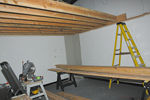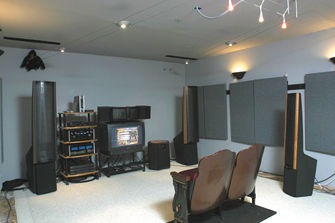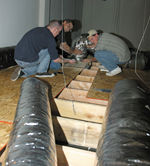Design the Ultimate Home Theater– On a Budget
Last month, I introduced some basic concepts to help you design the ultimate home theater. For those of you who missed it, we invited three home theater design gurus to help us build a new listening room: Anthony Grimani, Russ Herschelmann, and Norm Varney. I tried to cover everything you'd need to build a great home theater, regardless of your budget. This month, I continue that approach as I discuss the construction and acoustic treatment of our room.
 Construction
Construction
The main goals during your home theater's construction phase are noise isolation and build quality. Build quality refers to the types of materials you use during construction and the manner in which you use them. In a general sense, a well-constructed room with no rattles, buzzes, or loose parts will sound better than a room that has poorly secured materials. However, all materials have certain acoustic properties that affect how the room sounds. As I discuss our construction process, I'll talk about common building materials and their potential effect on sound quality.

 Noise isolation refers to how much outside noise reaches into your room and how much of your room's noise reaches the outside world. This may be only one factor in the room's ambient-noise level, though. You also have to consider interior noise from components, fan-cooled projectors, and the margarita blender. Lower noise levels increase the system's dynamic range, which is defined as the total range, in decibels, from the quietest to the loudest sounds. An NC (noise criteria) rating is a measurement of this ambient-noise level. The higher the NC number is, the worse the noise. For example, a room with an NC 40 rating has significant background noise and would be unacceptable as a good home theater. As Anthony points out, if the ambient-noise level is too high, low-level details will be lost. Increasing the volume will just compress the dynamic range, create distortion, or cause hearing damage. A room with an NC 30 rating might be OK, but an NC 20 rating is excellent.
Noise isolation refers to how much outside noise reaches into your room and how much of your room's noise reaches the outside world. This may be only one factor in the room's ambient-noise level, though. You also have to consider interior noise from components, fan-cooled projectors, and the margarita blender. Lower noise levels increase the system's dynamic range, which is defined as the total range, in decibels, from the quietest to the loudest sounds. An NC (noise criteria) rating is a measurement of this ambient-noise level. The higher the NC number is, the worse the noise. For example, a room with an NC 40 rating has significant background noise and would be unacceptable as a good home theater. As Anthony points out, if the ambient-noise level is too high, low-level details will be lost. Increasing the volume will just compress the dynamic range, create distortion, or cause hearing damage. A room with an NC 30 rating might be OK, but an NC 20 rating is excellent.
 Sound travels through nearly every material, which makes noise isolation difficult. Transmission-loss figures tell us how much sound is lost when it travels through a given partition. In acoustic texts, a wall, door, or ceiling partition is typically given a sound transmission class (STC) rating. This single-number rating tells you how well a partition assembly reduces noise from one side to the other. The higher the number is, the better the partition's ability to reduce noise. Transmission loss depends on frequency, however. Modern designers recognize that a material that's excellent at preventing transmission of upper frequencies may have no effect on lower frequencies. Home theater designers must take into consideration a material's STC at many different frequencies, rather than rely on one overall number.
Sound travels through nearly every material, which makes noise isolation difficult. Transmission-loss figures tell us how much sound is lost when it travels through a given partition. In acoustic texts, a wall, door, or ceiling partition is typically given a sound transmission class (STC) rating. This single-number rating tells you how well a partition assembly reduces noise from one side to the other. The higher the number is, the better the partition's ability to reduce noise. Transmission loss depends on frequency, however. Modern designers recognize that a material that's excellent at preventing transmission of upper frequencies may have no effect on lower frequencies. Home theater designers must take into consideration a material's STC at many different frequencies, rather than rely on one overall number.
 In general, partitions or materials with greater mass have greater transmission loss. However, greater mass can also decrease a material's absorption properties, and such materials are usually expensive, thick, and heavy. On the other hand, sandwiching an air space between materials can be an extremely effective way to limit sound transmission without the expense or acoustic loss of adding mass—if you can control the cavity's reverberant sound. One of the best ways to achieve excellent noise isolation is to isolate the home theater as a separate room, with an insulated air space between it and your home's adjacent walls, floors, and ceilings.
In general, partitions or materials with greater mass have greater transmission loss. However, greater mass can also decrease a material's absorption properties, and such materials are usually expensive, thick, and heavy. On the other hand, sandwiching an air space between materials can be an extremely effective way to limit sound transmission without the expense or acoustic loss of adding mass—if you can control the cavity's reverberant sound. One of the best ways to achieve excellent noise isolation is to isolate the home theater as a separate room, with an insulated air space between it and your home's adjacent walls, floors, and ceilings.





























































